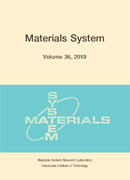Current issue
Displaying 1-7 of 7 articles from this issue
- |<
- <
- 1
- >
- >|
-
2025 Volume 42 Pages 1
Published: March 12, 2025
Released on J-STAGE: March 27, 2025
Download PDF (203K) -
2025 Volume 42 Pages 3-20
Published: March 12, 2025
Released on J-STAGE: March 27, 2025
Download PDF (3035K) -
2025 Volume 42 Pages 21-26
Published: March 12, 2025
Released on J-STAGE: March 27, 2025
Download PDF (2855K) -
2025 Volume 42 Pages 27-33
Published: March 12, 2025
Released on J-STAGE: March 27, 2025
Download PDF (1294K) -
2025 Volume 42 Pages 35-40
Published: March 12, 2025
Released on J-STAGE: March 27, 2025
Download PDF (1497K) -
2025 Volume 42 Pages 41-47
Published: March 12, 2025
Released on J-STAGE: March 27, 2025
Download PDF (1283K) -
2025 Volume 42 Pages 49-59
Published: March 12, 2025
Released on J-STAGE: March 27, 2025
Download PDF (1925K)
- |<
- <
- 1
- >
- >|
